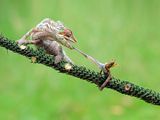Which Statement Best Describes Animals That Are Heterotrophs
A heterotroph is an organism that eats other plants or animals for energy and nutrients. The term stems from the Greek words hetero for "other" and trophe for "nourishment." Organisms are characterized into two broad categories based upon how they obtain their free energy and nutrients: autotrophs and heterotrophs. Autotrophs are known equally producers because they are able to brand their own nutrient from raw materials and energy. Examples include plants, algae, and some types of bacteria. Heterotrophs are known as consumers because they swallow producers or other consumers. Dogs, birds, fish, and humans are all examples of heterotrophs. Heterotrophs occupy the 2d and third levels in a food chain, a sequence of organisms that provide energy and nutrients for other organisms. Each food chain consists of iii trophic levels, which draw an organism's office in an ecosystem. Occupying the first trophic level are autotrophs, such as plants and algae. Herbivores—organisms that eat plants—occupy the second level. Carnivores (organisms that eat meat) and omnivores (organisms that eat plants and meat) occupy the third level. Both primary (herbivores) and secondary (carnivores and omnivores) consumers are heterotrophs, while main producers are autotrophs. A 3rd type of heterotrophic consumer is a detritivore. These organisms obtain food past feeding on the remains of plants and animals equally well as fecal affair. Detritivores play an important office in maintaining a good for you ecosystem by recycling waste. Examples of detritivores include fungi, worms, and insects. There are 2 subcategories of heterotrophs: photoheterotrophs and chemoheterotrophs. Photoheterotrophs are organisms that get their energy from calorie-free, merely must withal eat carbon from other organisms, as they cannot utilize carbon dioxide from the air. Chemoheterotrophs, by contrast, go both their energy and carbon from other organisms. A major difference between autotrophs and heterotrophs is that the former are able to make their ain food by photosynthesis whereas the latter cannot. Photosynthesis is a process that involves making glucose (a sugar) and oxygen from water and carbon dioxide using free energy from sunlight. Autotrophs are able to industry free energy from the sunday, but heterotrophs must rely on other organisms for free energy. Another major difference betwixt autotrophs and heterotrophs is that autotrophs take an important pigment called chlorophyll, which enables them to capture the energy of sunlight during photosynthesis, whereas heterotrophs do not. Without this pigment, photosynthesis could not occur. Heterotrophs do good from photosynthesis in a variety of ways. They depend on the process for oxygen, which is produced as a byproduct during photosynthesis. Moreover, photosynthesis sustains the autotrophs that heterotrophs depend on to survive. While meat-eating carnivores may non directly depend on photosynthetic plants to survive, they practise depend on other animals that consume photosynthetic plants every bit a food source.

Chameleons are a bizarre and colorful case of a heterotroph, an organism that consumes other animals or plants – like this unfortunate cricket – to sustain itself.
Photograph by kuritafsheen
algae
Plural Substantive
(singular: alga) diverse group of aquatic organisms, the largest of which are seaweeds.
Noun
organism that can produce its ain food and nutrients from chemicals in the temper, unremarkably through photosynthesis or chemosynthesis.
Plural Noun
(singular: bacterium) unmarried-celled organisms found in every ecosystem on Earth.
carbon
Substantive
chemical element with the symbol C, which forms the basis of all known life.
Substantive
organism that eats meat.
chemoheterotroph
Substantive
organism that consumes other organisms and undergoes chemosynthesis for energy
Noun
plants' light-green pigment that is essential to photosynthesis.
detritivore
Noun
organism that consumes dead found cloth.
Noun
grouping of organisms linked in order of the nutrient they eat, from producers to consumers, and from prey, predators, scavengers, and decomposers.
glucose
Noun
"unproblematic sugar" chemic produced past many plants during photosynthesis.
Noun
organism that eats mainly plants and other producers.
Noun
organism that cannot brand its ain nutrients and must rely on other organisms for food.
Noun
organism that eats a variety of organisms, including plants, animals, and fungi.
oxygen
Noun
chemical element with the symbol O, whose gas grade is 21% of the Earth'due south atmosphere.
photoheterotroph
Substantive
organism that uses sunlight and carbon from organic compounds for energy
Noun
process by which plants plough water, sunlight, and carbon dioxide into water, oxygen, and simple sugars.
Source: https://www.nationalgeographic.org/encyclopedia/heterotrophs/
Posted by: crosslond1967.blogspot.com

0 Response to "Which Statement Best Describes Animals That Are Heterotrophs"
Post a Comment